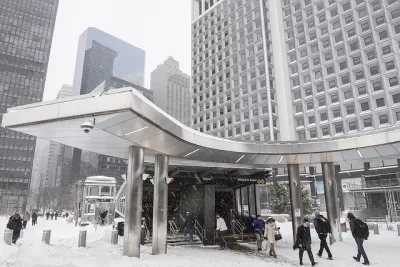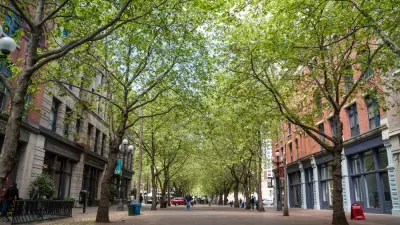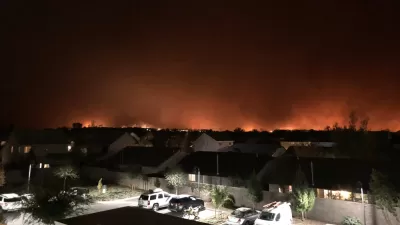When President Trump tweeted that the East Coast needed global warming due to the freezing cold, experts responded by explaining the difference between weather and climate. But climate change may indeed be a cause of the bomb cyclone.

In addition to distinguishing between weather and climate in response to the president's global warming tweet on Dec. 28 about the extreme cold, the discourse also suggests that climate change may be a more accurate term to use in light of Trump's attempt at humor. The National Oceanic and Atmospheric Administration (NOAA) distinguishes the two terms.
Global warming refers only to the Earth’s rising surface temperature, while climate change includes warming and the “side effects” of warming—like melting glaciers, heavier rainstorms, or more frequent drought. Said another way, global warming is one symptom of the much larger problem of human-caused climate change.
Which brings us to the brutal cold on the East Coast and how climate change is affecting the jet stream.
"As bitter cold continues to grip much of North America and helps spawn the fierce storm along the East Coast, the question arises: What’s the influence of climate change?" asks Henry Fountain, who covers climate change for The New York Times, on Jan. 3.
The Arctic is not as cold as it used to be — the region is warming faster than any other — and studies suggest that this warming is weakening the jet stream, which ordinarily acts like a giant lasso, corralling cold air around the pole.
[Speaking of the Arctic, another response to Trump would have been to observe that while it was indeed cold on the East Coast, it was also warmer in Alaska (49 degrees) than Jacksonville, Fla.(41 degrees) on Jan. 2].
The reason a direct connection between cold weather and global warming is still up for debate, scientists say, is that there are many other factors involved. Ocean temperatures in the tropics, soil moisture, snow cover, even the long-term natural variability of large ocean systems all can influence the jet stream.
And as with any single weather event, it’s difficult to directly attribute the influence of climate change to a particular cold spell.
According to one researcher, "the jet stream — usually referred to as the polar vortex this time of year — is weakening more frequently and staying weaker for longer periods of time," writes Fountain. Another researcher points to the warming of the Arctic as the reason for the weakening.
The result: polar jet stream winds, which blow from west to east, are susceptible to "disturbances, such as a zone of high pressure that can force colder air southward," adds Fountain.
The current cold snap has been in place for more than a week, and the cold air on Wednesday [Jan. 3] was moving east and colliding with a mass of warmer air from the Atlantic Ocean. That created a storm known as a “bomb cyclone.”
For those on the East Coast looking for relief from the extreme cold, Fountain ends his report on a grim outlook.
But one impact of the storm is even more clear: After it eventually moves off to the north and west, it should draw even more cold polar air into the eastern half of the United States, continuing the big chill.
However, a check of the weather forecast shows high temperatures rising above freezing for New York City this week.
Hat tip to Dino Grandoni via The Washington Post's Energy 202 newsletter.
FULL STORY: Why So Cold? Climate Change May Be Part of the Answer

Alabama: Trump Terminates Settlements for Black Communities Harmed By Raw Sewage
Trump deemed the landmark civil rights agreement “illegal DEI and environmental justice policy.”

Study: Maui’s Plan to Convert Vacation Rentals to Long-Term Housing Could Cause Nearly $1 Billion Economic Loss
The plan would reduce visitor accommodation by 25% resulting in 1,900 jobs lost.

Planetizen Federal Action Tracker
A weekly monitor of how Trump’s orders and actions are impacting planners and planning in America.

Waymo Gets Permission to Map SF’s Market Street
If allowed to operate on the traffic-restricted street, Waymo’s autonomous taxis would have a leg up over ride-hailing competitors — and counter the city’s efforts to grow bike and pedestrian on the thoroughfare.

Parklet Symposium Highlights the Success of Shared Spaces
Parklets got a boost during the Covid-19 pandemic, when the concept was translated to outdoor dining programs that offered restaurants a lifeline during the shutdown.

Federal Homelessness Agency Places Entire Staff on Leave
The U.S. Interagency Council on Homelessness is the only federal agency dedicated to preventing and ending homelessness.
Urban Design for Planners 1: Software Tools
This six-course series explores essential urban design concepts using open source software and equips planners with the tools they need to participate fully in the urban design process.
Planning for Universal Design
Learn the tools for implementing Universal Design in planning regulations.
Caltrans
Smith Gee Studio
Institute for Housing and Urban Development Studies (IHS)
City of Grandview
Harvard GSD Executive Education
Toledo-Lucas County Plan Commissions
Salt Lake City
NYU Wagner Graduate School of Public Service





























